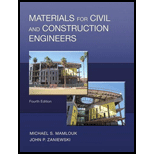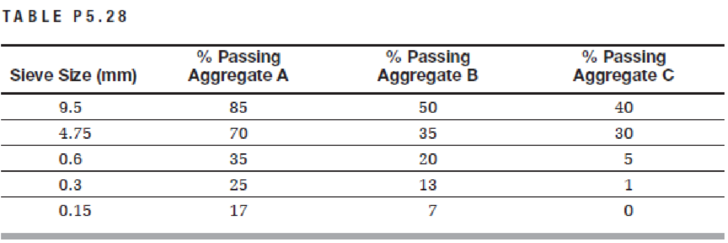
Pearson eText for Materials for Civil and Construction Engineers -- Instant Access (Pearson+)
4th Edition
ISBN: 9780137505586
Author: Michael Mamlouk, John Zaniewski
Publisher: PEARSON+
expand_more
expand_more
format_list_bulleted
Textbook Question
Chapter 5, Problem 5.28QP
Three aggregates are to be mixed together in the following ratio:
Aggregate A: 35%
Aggregate B: 40%
Aggregate C: 25%
For each aggregate, the percent passing a set of five sieves is shown in Table P5.28.
Determine the percent passing each sieve for the blended aggregate.

Expert Solution & Answer
Want to see the full answer?
Check out a sample textbook solution
Students have asked these similar questions
5.17 Calculate the sieve analysis of the following aggregate and plot on a semilog
gradation paper. What is the maximum size? What is the nominal maximum
size?
Sieve Size
25 mm (1 in.)
9.5 mm (3/8 in.)
4.75 mm (No. 4)
2.00 mm (No. 10)
0.425 mm (No. 40)
0.075 mm (No.200)
Pan
Amount Cumulative Amount Cumulative Percent
Retained, g
Retained, g
0
47.1
239.4
176.5
92.7
73.5
9.6
Retained
Percent
Passing
Three aggregates are to be mixed together in the following ratio:Aggregate A: 35%Aggregate B: 40%Aggregate C: 25%For each aggregate, the percent passing a set of five sieves is shown in Table PDetermine the percent passing each sieve for the blended aggregate.
Table P5.27 shows the grain size distributions of aggregates A, B, and C. The
three aggregates must be blended at a ratio of 15:25:60 by weight, respectively.
Using a spreadsheet program, determine the grain size distribution of the blend.
TABLE P5.27
Percent Passing
Sieve Size, mm
25
19
12.5
9.5
4.75
1.18
0.60
0.30
0.15
Aggregate A
100
100
100
77
70
42
34
28
20
Aggregate B
100
85
62
43
24
13
Aggregate C
100
100
84
51
29
19
18
14
9.
Chapter 5 Solutions
Pearson eText for Materials for Civil and Construction Engineers -- Instant Access (Pearson+)
Ch. 5 - Prob. 5.1QPCh. 5 - Discuss five different desirable characteristics...Ch. 5 - Discuss five different desirable characteristics...Ch. 5 - The shape and surface texture of aggregate...Ch. 5 - Define the following terms: a. Saturated...Ch. 5 - Three samples of fine aggregate have the...Ch. 5 - A sample of wet aggregate weighed 297.2 N. After...Ch. 5 - 46.5 kg (102.3 lb) of fine aggregate is mixed with...Ch. 5 - Samples of coarse aggregate from a stockpile are...Ch. 5 - Base course aggregate has a target dry density of...
Ch. 5 - Calculate the percent voids between aggregate...Ch. 5 - Calculate the percent voids between aggregate...Ch. 5 - Coarse aggregate is placed in a rigid bucket and...Ch. 5 - The following laboratory tests are performed on...Ch. 5 - Students in the materials lab performed the...Ch. 5 - The specific gravity and absorption test (ASTM...Ch. 5 - Prob. 5.18QPCh. 5 - Calculate the sieve analysis shown in Table P5.19...Ch. 5 - Calculate the sieve analysis shown in Table P5.20,...Ch. 5 - A sieve analysis test was performed on a sample of...Ch. 5 - A sieve analysis test was performed on a sample of...Ch. 5 - Draw a graph to show the cumulative percent...Ch. 5 - Referring to Table 5.6, plot the specification...Ch. 5 - Referring to the aggregate gradations A, B, and C...Ch. 5 - Table P5.26 shows the grain size distributions of...Ch. 5 - Table P5.27 shows the grain size distributions of...Ch. 5 - Three aggregates are to be mixed together in the...Ch. 5 - Table P5.29 shows the grain size distribution for...Ch. 5 - Laboratory specific gravity and absorption tests...Ch. 5 - Table P5.31 shows the grain size distribution for...Ch. 5 - Prob. 5.32QPCh. 5 - Laboratory specific gravity and absorption tests...Ch. 5 - Prob. 5.34QPCh. 5 - Define the fineness modulus of aggregate. What is...Ch. 5 - Calculate the fineness modulus of aggregate A in...Ch. 5 - Calculate the fineness modulus of aggregate B in...Ch. 5 - A portland cement concrete mix requires mixing...Ch. 5 - Discuss the effect of the amount of material...Ch. 5 - Aggregates from three sources having the...Ch. 5 - Aggregates from three sources having the...Ch. 5 - A contractor is considering using three stockpiles...Ch. 5 - Prob. 5.43QPCh. 5 - What are the typical deleterious substances in...Ch. 5 - Review ASTM D75 and summarize the following: a....
Knowledge Booster
Learn more about
Need a deep-dive on the concept behind this application? Look no further. Learn more about this topic, civil-engineering and related others by exploring similar questions and additional content below.Similar questions
- 5.24 Three aggregates are to be mixed together in the following ratio: Aggregate A 35% Aggregate B 40% Aggregate C 25% For each aggregate, the percent passing a set of five sieves is shown in the fol- lowing table: Sieve Size (mm) % Passing Agg. A % Passing Agg. B % Passing Agg. C 9.5 85 50 40 4.75 70 35 30 0.6 35 20 0.3 25 13 1 0.15 17 7 Determine the percent passing each sieve for the blended aggregate.arrow_forwardA sieve analysis test was performed on a sample of aggregate and produced the results shown in Table. Calculate the percent passing through each sieve. What is the maximum size? What is the nominal maximum size? Plot the percent passing versus sieve size on: a. a semilog gradation chart, and b. a 0.45 gradation chart (Figure A.25). Amount Retained, (g) Cumulative Percent Retained SIEVE ΝΟ. SIEVE SIZE Cumulative Amount Percent Passing Retained, (g) 215 885 980 12 2,350 3/8 1,190 4 2,205 8 1,985 10 1,840 40 1.650 100 980 200 660 PAN 60 ΤΟΤAL 15,000arrow_forwardTable shows the grain size distributions of aggregates A, B, and C. The three aggregates must be blended at a ratio of 15:25:60 by weight, respectively.Using a spreadsheet program, determine the grain size distribution of the blend.arrow_forward
- the Nominal Maximum aggregate Size (N.M.S) for the aggregate gradation shown below is equal to Sieve size Passing % 3/4 inch 100 1/2 inch 3/8 inch 99 89 No.4 72 No.8 65 No.30 22 No.200 Your answer 4-arrow_forwardA coarse aggregate sample was dried in an oven for 1.5 hours before it was immersed in water for 24 hours then rolled in an absorbent cloth to dry the surfaces of the aggregate. The weight in this condition is found to be 3002 g. It was transferred to a density basket to determine its weight in water which was recorded to be 1910 g. it was then poured in a drying pan and dried in the oven. The weight after drying was 2965 g. Compute the following: a. Bulk Specific Gravity (oven dry) b. Bulk Specific Gravity (SSD) c. Apparent Specific Gravity d. Absorption in %arrow_forward4-33. Following are results of gradation tests on three aggregates: Aggregate A 100% 92% 41% 19% 7% 4% 2% 1% Passing 25 mm (1 in.) 19 mm (3/4 in.) 9.5 mm (3/8 in.) 4.75 mm (No. 4) 2.36 mm (No. 8) 600 μm (No. 30) 300 μm (No. 50) 75 μm (No. 200) Aggregate B 100% 77% 60% 42% 36% 28% Aggregate C 100% 96% 79% 40% 16% 3% Combine these to give a gradation falling approximately in the center of the specification given in Section 4-5.1.arrow_forward
- A sieve analysis test was performed on a sample of aggregate and produced the results shown in Table .Calculate the percent passing through each sieve. Plot the percent passingversus sieve size on:a. a semilog gradation chart, andb. a 0.45 gradation chart (Figure A.25).What is the maximum size? What is the nominal maximum size?arrow_forwardANALYTIC APPROACH IN AGGREGATES 5 set of sieves are to be used for analysis of aggregates. After sieve shaking the sieves, the mass of aggregates that retained on the 1st sieve is 50.26% of the total mass of the sample and the mass of aggregates that retained on the 2nd sieve is 20.26% of the total mass. The mass of the aggregates that passed through the 3rd sieve and 4th sieve is 42.81% and 8.628%, respectively, of the difference of the mass of aggregates that retained on the 1" and 2nd sieve. The mass of aggregates on the pan is 0.4105% of the total mass of the sample – which is 2.6 kg. Complete the table on the worksheet provided and round off to two decimal places.arrow_forward7. Make a spread sheet blend template program to perform a blend gradation analysis for up to four stockpiles with the ability to produce automatically semilog or power 0.45 gradation charts. Use the table to demonstrate the template, and calculate the fineness modulus for the aggregate D. Aggregate Blend Percent (%) Sieve size (mm) 37.5 25 19 12.5 9.5 4.75 2.36 1.18 0.60 0.30 0.15 0.075 A 20 100 100 95 89 70 10 2 N|N 2 2 2 2 2 B 25 100 100 100 100 82 55 15 55 32 2 1 с 25 Percent Passing 100 100 100 100 100 100 69 55 35 22 15 6 D 30 100 100 100 100 100 100 86 54 34 25 14 5arrow_forward
- 1. Three samples of aggregates are sieved to obtain the grading curve. A set of different sieves is stacked with the coarsest mesh at the top. The aggregate is then placed in the top sieve and the stack is placed in a sieve shaker. The raw data is as follows: Sieve size (mm) 19 9.5 4.75 2.36 1.18 0.6 0.3 0.15 Pan Mass of sieve (g) 670 620 620 570 570 520 520 520 490 For each sample: Plot the grading curve. a. b. Identify the type of gradation. c. Determine the fineness modulus. Mass of sieve + aggregates retained (g) Sample B mass of the empty measure mass of measure + water Sample A 670 770 820 740 720 770 720 570 525 mass of measure + rodded aggregates mass of measure + loose aggregates 670 1820 620 570 570 670 720 620 544 2. The rodded and loose bulk density of an aggregate sample is to be determined. The following are acquired during the experiment: - 12.15 kg - 27.15 kg - 34.60 kg - 25.16 kg Sample C 670 620 620 670 770 720 620 620 506arrow_forwardReferring to the aggregate gradations A, B, and C in Figure P5.26, answer the following questions: a. What is the maximum size of each gradation? b. What is the nominal maximum size of each gradation? c. Classify each gradation as dense, open, or gap indicating the reason for each classification. 100 A 80- 60 40 0.075 0.30 1.18 2.36 4.75 9.5 12.5 19.0 25.0 0.15 0.60 Sieve sizes (mm) FIGURE P5.26 Percent passing 20arrow_forwardWhat will be the mixing ratio of X aggregate when the following aggregates are mixed in such a way that they pass 87% through the 16 mm sieve? Sieve size, mm Passing (%) a. %60 Lütfen birini seçin: b. %40 X C. %55 Y d. %50 DO 8 100 80 60 4 0 QUIE 100 100 85 55 2 HID 0 1 0 0.5 0.25 30 20 10arrow_forward
arrow_back_ios
SEE MORE QUESTIONS
arrow_forward_ios
Recommended textbooks for you

 Structural Analysis (10th Edition)Civil EngineeringISBN:9780134610672Author:Russell C. HibbelerPublisher:PEARSON
Structural Analysis (10th Edition)Civil EngineeringISBN:9780134610672Author:Russell C. HibbelerPublisher:PEARSON Principles of Foundation Engineering (MindTap Cou...Civil EngineeringISBN:9781337705028Author:Braja M. Das, Nagaratnam SivakuganPublisher:Cengage Learning
Principles of Foundation Engineering (MindTap Cou...Civil EngineeringISBN:9781337705028Author:Braja M. Das, Nagaratnam SivakuganPublisher:Cengage Learning Fundamentals of Structural AnalysisCivil EngineeringISBN:9780073398006Author:Kenneth M. Leet Emeritus, Chia-Ming Uang, Joel LanningPublisher:McGraw-Hill Education
Fundamentals of Structural AnalysisCivil EngineeringISBN:9780073398006Author:Kenneth M. Leet Emeritus, Chia-Ming Uang, Joel LanningPublisher:McGraw-Hill Education
 Traffic and Highway EngineeringCivil EngineeringISBN:9781305156241Author:Garber, Nicholas J.Publisher:Cengage Learning
Traffic and Highway EngineeringCivil EngineeringISBN:9781305156241Author:Garber, Nicholas J.Publisher:Cengage Learning


Structural Analysis (10th Edition)
Civil Engineering
ISBN:9780134610672
Author:Russell C. Hibbeler
Publisher:PEARSON

Principles of Foundation Engineering (MindTap Cou...
Civil Engineering
ISBN:9781337705028
Author:Braja M. Das, Nagaratnam Sivakugan
Publisher:Cengage Learning

Fundamentals of Structural Analysis
Civil Engineering
ISBN:9780073398006
Author:Kenneth M. Leet Emeritus, Chia-Ming Uang, Joel Lanning
Publisher:McGraw-Hill Education


Traffic and Highway Engineering
Civil Engineering
ISBN:9781305156241
Author:Garber, Nicholas J.
Publisher:Cengage Learning
Aggregates: Properties; Author: nptelhrd;https://www.youtube.com/watch?v=49yGZYeokKM;License: Standard YouTube License, CC-BY